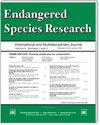Feeding ecology of harbour porpoises Phocoena phocoena stranded on the Galician coast (NW Spain) between 1990 and 2018
IF 2.9
2区 环境科学与生态学
Q2 BIODIVERSITY CONSERVATION
引用次数: 0
Abstract
ABSTRACT: Diet studies on the endangered and genetically distinct Iberian population of the southern harbour porpoise Phocoena phocoena are scarce. The present study provides updated information on the feeding ecology of this cetacean along the Galician coast (NW Spain) over the last 3 decades (1990-2018). The stomach contents of 72 stranded harbour porpoises were analysed to determine diet composition, to study which factors affect dietary variability and to estimate overlap between harbour porpoise diet and the target species of the fisheries in the study area, one of the most important fishing regions in Europe. Results showed that harbour porpoises are mainly piscivorous. We identified 33 prey taxa, but only 4 were important in the diet: fish of the genus Trisopterus, blue whiting Micromesistius poutassou, Atlantic horse mackerel Trachurus trachurus and European hake Merluccius merluccius. Interannual and ontogenetic variability in the diet were statistically significant, although differences in diet between sexes or between seasons were not detected. The diet of harbour porpoises from the Galician coast shows a partial overlap with fisheries catches in the area in terms of commercial fish species (≈61%) and size classes (≈45%), confirming the potential vulnerability of the Iberian population to interactions with fishing activities (i.e. bycatch in fishing gear and/or reduced prey availability).1990 年至 2018 年间搁浅在加利西亚海岸(西班牙西北部)的港湾鼠海豚的摄食生态学
摘要:对濒临灭绝且基因独特的伊比利亚南部港湾鼠海豚(Phocoena phocoena)种群的饮食研究很少。本研究提供了过去 30 年(1990-2018 年)加利西亚海岸(西班牙西北部)鲸类觅食生态学的最新信息。对 72 只搁浅的港湾鼠海豚的胃内容物进行了分析,以确定其饮食组成,研究哪些因素会影响饮食的可变性,并估计港湾鼠海豚饮食与研究区域(欧洲最重要的捕鱼区之一)渔业目标物种之间的重叠情况。结果表明,港湾鼠海豚主要以食鱼为主。我们确定了 33 种猎物分类群,但只有 4 种在江豚的食物中占重要地位:三蝶鱼属鱼类、蓝鳕鱼 Micromesistius poutassou、大西洋竹荚鱼 Trachurus trachurus 和欧洲无须鳕 Merluccius merluccius。虽然没有发现不同性别或不同季节江豚的食性存在差异,但江豚食性的年际变化和个体发育变化在统计学上具有显著意义。加利西亚海岸港湾鼠海豚的食物与该地区渔业捕捞的商品鱼类(≈61%)和大小级别(≈45%)有部分重叠,这证实了伊比利亚种群可能容易受到渔业活动的影响(即渔具误捕和/或猎物供应减少)。
本文章由计算机程序翻译,如有差异,请以英文原文为准。
求助全文
约1分钟内获得全文
求助全文
来源期刊

Endangered Species Research
BIODIVERSITY CONSERVATION-
CiteScore
5.50
自引率
6.50%
发文量
38
审稿时长
31 weeks
期刊介绍:
ESR is international and interdisciplinary. It covers all endangered forms of life on Earth, the threats faced by species and their habitats and the necessary steps that must be undertaken to ensure their conservation. ESR publishes high quality contributions reporting research on all species (and habitats) of conservation concern, whether they be classified as Near Threatened or Threatened (Endangered or Vulnerable) by the International Union for the Conservation of Nature and Natural Resources (IUCN) or highlighted as part of national or regional conservation strategies. Submissions on all aspects of conservation science are welcome.
 求助内容:
求助内容: 应助结果提醒方式:
应助结果提醒方式:


